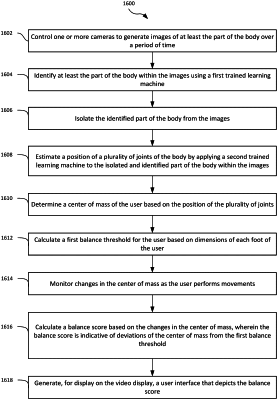| CPC G06N 3/08 (2013.01) [A63B 24/0062 (2013.01); A63B 71/0622 (2013.01); A63B 71/0669 (2013.01); G06F 18/22 (2023.01); G06T 7/20 (2013.01); G06T 7/55 (2017.01); G06T 7/66 (2017.01); G06T 7/70 (2017.01); G06T 19/006 (2013.01); G06V 10/764 (2022.01); G06V 20/20 (2022.01); G06V 20/653 (2022.01); G06V 40/10 (2022.01); G06V 40/23 (2022.01); H04N 7/147 (2013.01); A63B 2024/0068 (2013.01); A63B 2071/0647 (2013.01); A63B 2220/05 (2013.01); A63B 2220/806 (2013.01); A63B 2225/20 (2013.01); A63B 2230/62 (2013.01); G06T 2207/10016 (2013.01); G06T 2207/10028 (2013.01); G06T 2207/20081 (2013.01); G06T 2207/30196 (2013.01)] | 20 Claims |

|
1. A system for evaluating physical balance of a user, comprising:
a video display; and
a computing device comprising:
a memory storing computer executable instructions; and
a processor configured to execute the computer executable instructions to:
control the video display to display a visual video stream captured by one or more cameras of at least a part of a body of the user over a period of time;
identify at least the part of the body within the video stream;
estimate a position of a plurality of joints of the part of the body by applying at least one trained learning machine stream;
determine a balance metric of the user based on the position of the plurality of joints;
calculate a balance threshold for the user based on dimensions of each foot of the user or based on movement relative dimensions of the part of the body;
monitor changes in the balance metric as the user performs movements; and
calculate a balance score based on the changes in the balance metric,
wherein the balance score is indicative of deviations of the balance metric from the balance threshold.
|